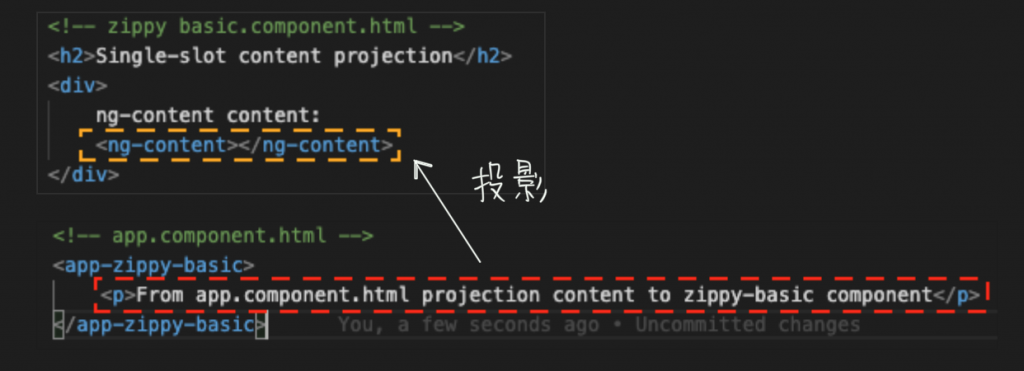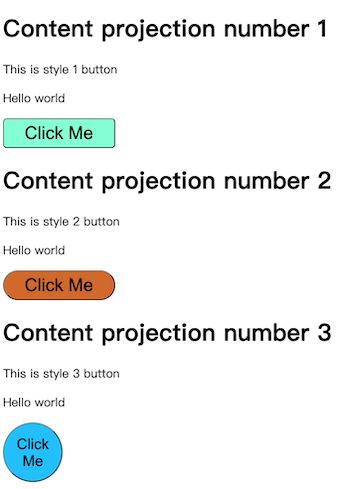本章節將要介紹如何使用 ng-content 將一個 Component 的內容投影到另一個 Component 中,創建靈活且可被重複使用的 Component,來滿足程式設計中 DRY (Don't repeat yourself) 的觀念。
在 Angular 中 Content 是一種呈現的模式,可以在其中插入或投影另一個 Component 的內容,簡單來說,當我們在寫 HTML 時常常會有這樣的結構:
<div>
<p> Hello World!</p>
</div>
在 Angular 的概念中可以把它想像成,有一個 <p> tag 被投影到 <div> 之中,雖然不是原理可能不這樣子,但是類似的模式。
在 Angular 中有幾種常見的 ng-content 例子:

在 Angular 的 ng-content 中最基本的就是 single-slot content projection,他是指將一個 Component 的內容投影在另一個 Component 之中,我們做一個簡單的小例子來解釋這個行為。
首先我們先使用 Angular CLI 建立一個 Component
ng generate component zippy-basic
ng g c zippy-basic
在 zippy-basic.component.html 中添加 ng-content 到你希望投影內容出現的位置
<!-- zippy basic.component.html -->
<h2>Single-slot content projection</h2>
<div>
ng-content content:
<ng-content></ng-content>
</div>
接著我們在 app.component.html 中使用 zippy-basic 的 selector
<!-- app.component.html -->
<app-zippy-basic></app-zippy-basic>

在畫面中我們看到,我們使用 ng-content 的位置什麼都沒有,是出了什麼 bug 嗎?其實不是![]() ,是因為我們還沒決定該把什麼內容投影在 的位置上,我們來更改一下 app.component.html 的內容
,是因為我們還沒決定該把什麼內容投影在 的位置上,我們來更改一下 app.component.html 的內容
<!-- app.component.html -->
<app-zippy-basic>
<p>From app.component.html projection content to zippy-basic component</p>
</app-zippy-basic>

當更改玩 app.component.html 的內容後,可以在畫面中看到,Angular 把我們夾在 <app-zippy-basic> 的內容放到 <ng-content> 的位置了,
當然可能有人會問了,那...我直接把 <p> 放在 zippy-basic.component.html 不就好了嗎?![]()
<!-- zippy basic.component.html -->
<h2>Single-slot content projection</h2>
<div>
ng-content content:
<p>From app.component.html projection content to zippy-basic component</p>
</div>
沒有錯,但是其實 ng-content 通常不是讓你放 html tag 的,我們來舉個例子,想像一下一個場景,當你在開發專案時,有沒有遇到在一個地方需要放置三種不同類型的 button ? 如果是這樣的話你是不是會這麼做
<div>
<!-- style1 button -->
<label>This is style 1 button</label>
<p>Hello world</p>
<button>button</button>
<div>
<div>
<!-- style2 button -->
<label> This is style 2 button </label>
<p>Hello world</p>
<button>button</button>
<div>
<div>
<!-- style3 button -->
<label> This is style 3 button </label>
<p>Hello world</p>
<button>button</button>
<div>
有沒有發現當使用上面這種 HTML 結構雖然可以達到我們要的目的,但是 <label>、<p>、<button> 一直在重複出現但內容卻是一樣的,就違背了 DRY 的原則了,這時候我們就可以使用 ng-content 先將模板做好,再把不同 style 的 投影進去就好,來舉個例子吧:
首先我們先建立一個模板 Component
ng generate component content-template
ng g c content-template
接著我們在 content-template.component.html 中把我們的模板寫好
<!-- content-template.component.html -->
<h1>Content projection number {{styleCount}}</h1>
<label>This is style {{styleCount}} button</label>
<p>Hello world</p>
<ng-content></ng-content>
我們在原本放置不同 style 的地方使用 變成將別的內容投影到這個位置上,對了還記得昨天提到的 @Input( ) 嗎? 這邊我們來複習一下,使用 ng-content 一樣可以由父層傳遞數據到子層喔。
import { Component, Input } from '@angular/core';
@Component({
selector: 'app-content-template',
templateUrl: './content-template.component.html',
})
export class ContentTemplateComponent {
@Input() styleCount: string = '';
constructor() { }
}
接著我們來更改一下 app.component.html 的內容,讓不同 style 的 button 投影到 content-template 吧
<!-- app.component.html -->
<app-content-template [styleCount]="'1'">
<button class="style1">Click Me</button>
</app-content-template>
<app-content-template [styleCount]="'2'">
<button class="style2">Click Me</button>
</app-content-template>
<app-content-template [styleCount]="'3'">
<button class="style3">Click Me</button>
</app-content-template>

這樣就完成了我們的目的,簡單的幾行就可以達到相同的目的,透過先建立模板再將不同樣式或不同的 Component 投影進這個模板 Component 之中,就可以讓這個模板 Component 在各個地方都被使用並且達到減少重複程式碼的目的。
第二種其實與第一種非常相似,只不過變成了一個 Component 中投影了多個不同的內容,不過值得注意的是,由於是多個不同的內容投影在一個 Component 之中,所以就會有順序位置問題,於是 Angular 提供了 select 屬性讓你加在 ng-content 上,讓你可以將某一個內容放在指定的位置上,一樣舉個例子吧。
首先一樣創建一個新的 Component
ng generate component zippy-basic
ng g c zippy-basic
接著我們在 zippy-basic.component.html 中添加 ng-content 到想要的位置
<!-- zippy-basic.component.html -->
<h2>Multi-slot content projection</h2>
Default:
<ng-content></ng-content>
Question:
<ng-content></ng-content>
接著我們把想要的位置添加一個 select 屬性,讓投影的位置固定在我們想要的地方
<!-- zippy-basic.component.html -->
<h2>Multi-slot content projection</h2>
Default:
<ng-content></ng-content>
Question:
<ng-content select="[question]"></ng-content>
最後我們在 app.component.html 中將我們像要投影的內容放進去,記得!指定位置的內容需要加上 select 的內容喔
<!-- app.component.html -->
<app-zippy-basic>
<p question>Is content projection cool?</p>
<p>Let's learn about content projection!</p>
</app-zippy-basic>

可以看到我們在 app.component.html 中 的順序與 UI 呈現的順序是顛倒的,就因為我們指定了有 question 這個 select 放置的地方。
與 Single-slot content projection 一樣,Multi-slot content projection 的目的不在於放入原生 HTML 的 Tag,目的與上一個一樣,都是可以先建立一個模板之後將不同的內容投影到這個模板中,只不過多了可以透過 select 讓你選擇放置的位置與讓你可以放多個投影,這邊就不在做一次練習了,有興趣的話可以自己挑戰一下利用 Multi-slot content projection 完成與上面的例子一樣的內容。
在本章中介紹了什麼是 content projection 以及該如何使用它,在官方文檔中其實除了 Single-slot content projection 與 Multi-slot content projection 之外其實還有第三個常見的投影 Conditional content projection,但是因為他牽扯的概念跟本篇章使用 ng-content 比較不一樣,他是透過使用 ng-template 來做到這個功能,所以就先不將它納入本章的範圍,這個方法會在之後介紹到。
下一篇將會分享 template 是什麼,他在 Angular 中是 HTML 的角色,而可以在 template 中使用許多語法來達到靈活建立畫面的功能,那我們就下一篇再見吧。
